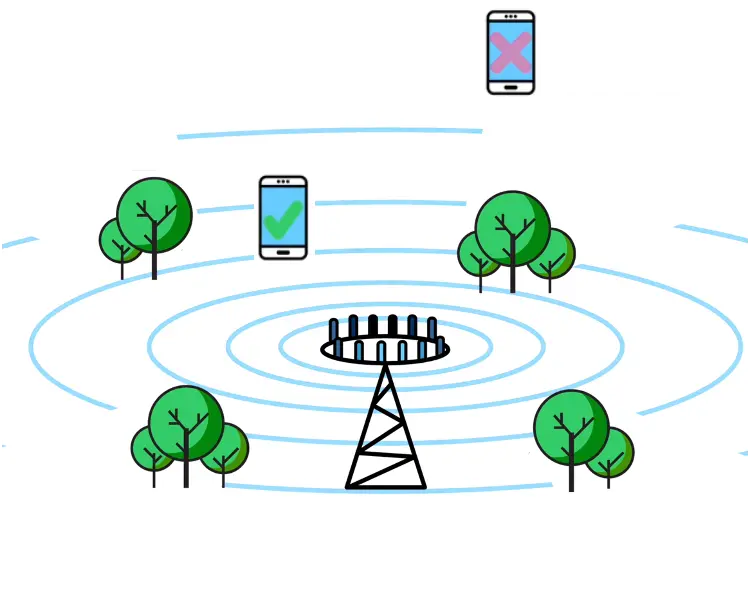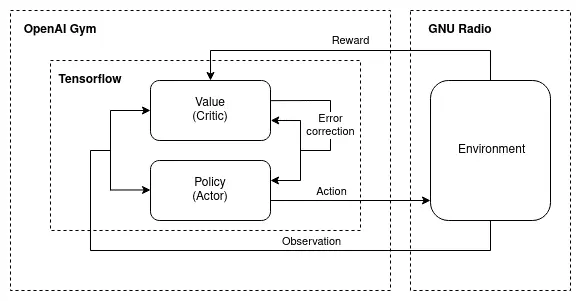In unserer Reihe "Motee Minute" lassen wir unsere Motees zu den neuesten Techniktrends zu Wort kommen - ungefiltert, offen und mit eigener Meinung. Diese Woche hören wir von Alberto. Alberto ist Solutions Architect und Senior Project Owner bei Motius. Sein Hauptfachgebiet ist Künstliche Intelligenz (KI) und Data Science-Anwendungen. Bevor er zu Motius kam, arbeitete Alberto im Audi AI Lab an Anwendungen für autonomes Fahren. Davor promovierte er am Deutschen Zentrum für Luft- und Raumfahrt (DLR) im Bereich maschinelles Lernen für Schwarmrobotik.
Ich werde oft gefragt: Was ist FunKI? Die Antwort ist ziemlich einfach:
FunKI = KI + 5G
Das klingt doch ganz einfach, oder? Es ist nicht so einfach und ich werde Ihnen in diesem Blogbeitrag erklären, warum. Beginnen wir also mit FunKI, indem wir zunächst KI und 5G-Technologien vorstellen.
Die Sache mit der KI
Wir haben es schon hundertmal gehört: Die künstliche Intelligenz ist das böse Wesen, das uns alle beherrschen, unsere Arbeitsplätze übernehmen und jeden unserer Schritte kontrollieren wird. Wir kaufen, was sie uns sagt, und wählen unsere Freunde nach ihrem Willen aus. Auf der anderen Seite sehen wir Schlagzeilen, in denen KI als das gute Wesen dargestellt wird, das unser Leben verbessern, die Fähigkeiten der Menschen erweitern und uns in Rente schicken wird, bevor wir überhaupt anfangen zu arbeiten.
Aber ist KI gut oder böse?
...und die Sache mit 5G
5G steht für die 5. Generation des Mobilfunknetzes. Einige schreien, dass 5G böse ist, dass es schlecht für unsere Gesundheit ist und es Bill Gates erlauben wird, uns durch Strahlungswellen, die von unseren Geräten ausgehen, zu überwachen und zu kontrollieren. Andere hingegen flüstern, dass 5G eine Technologie ist, mit der praktisch jeder und alles miteinander verbunden werden soll, einschließlich Maschinen, Gegenstände und Geräte. Stellen Sie sich vor, dass Milliarden vernetzter Geräte Informationen in Echtzeit sammeln und austauschen, was zu weniger Verkehrsunfällen führt; lebensrettende Anwendungen dank verzögerungsfreier garantierter Verbindungen; oder Produktionslinien, die so vorausschauend sind, dass sie Unterbrechungen verhindern können, lange bevor sie auftreten.
Und nun? Ist 5G gut oder böse?
Wie du vielleicht erwartest, stehen wir bei Motius auf der guten Seite. Wir sind Technologie-Liebhaber und glauben fest an die potenziellen Vorteile, die KI und 5G als Einzeltechnologien bringen können. Stelle dir also vor, was wir erreichen könnten, wenn wir dich in einem einzigen glorreichen Projekt zusammenführen. DAS ist FunKI!
"Was für eine Kombination! KI und 5G. Das ist es, worum es bei FunKI geht!"
Warum braucht 5G KI?
Kommunikationsfunktionen werden in der Regel durch das Open Systems Interconnection-Modell(OSI-Modell) beschrieben. Das OSI-Modell unterteilt den Datenfluss in einem Kommunikationssystem in sieben Abstraktionsschichten, von der physikalischen Implementierung der Übertragung von Bits über ein Kommunikationsmedium bis hin zur Darstellung der Daten einer verteilten Anwendung auf höchster Ebene.
KI-Techniken werden bereits erfolgreich auf den höheren Protokollschichten von 5G-Systemen eingesetzt. Im Gegensatz dazu wurden traditionelle mathematisch-abstrakte Modelle, die auf idealisierten Annahmen beruhen, nur in den ersten beiden Schichten verwendet, nämlich der physikalischen Schicht (PHY) und der Medienzugangsschicht (MAC).
Die teilweise widersprüchlichen Anforderungen an Zuverlässigkeit, Übertragungsrate, Anzahl der Endgeräte pro Gebiet, Latenz, verfügbare Funkressourcen, Energieeffizienz, Komplexität und Hardwarekosten erschweren zunehmend die Umsetzung mit traditionellen Methoden. Wenn z.B. die mathematische Modellierung des Problems nicht mehr möglich ist (Modelldefizit) oder zu einem sehr komplexen Modell führt (Algorithmusdefizit), stellen datengetriebene Methoden des maschinellen Lernens (ML) einen vielversprechenden Ansatz zum Verständnis des Modells sowie zum System- und Technologiedesign dar.
"Im FunKI untersuchen wir, wie 5G von datengesteuerten maschinellen Lernmethoden profitieren kann."
FunKI (Funkkommunikation mit Künstlicher Intelligenz) ist ein vom deutschen Bundesministerium für Bildung und Forschung (BMBF) gefördertes Forschungsprojekt. FunKI bringt acht Pionierteams zusammen, die Unternehmen (namentlich Intel, Nokia, Creonic und natürlich Motius) und Forscher (namentlich das DFKI und die Universitäten Bremen, Stuttgart und Kaiserslautern) auf den Gebieten der drahtlosen 5G-Kommunikation, der künstlichen Intelligenz und des mikroelektronischen Systemdesigns zusammenbringen, um die Herausforderungen bei der Umsetzung zukünftiger Kommunikationssysteme anzugehen.
In FunKI profitiert Motius von einem breiten Know-how, das in früheren Projekten im Bereich der KI und der drahtlosen Kommunikationstechnologie erworben wurde. Wir nutzen diese Expertise, um einige Schlüsseltechnologien für 5G zu erforschen. Lasse uns nun ein wenig technischer werden, um gemeinsam mit dem Motius-Team, das an diesem Projekt arbeitet, tiefer in FunKI einzutauchen.
Das Motius FunKI-Team
Unser Team besteht aus vier Ingenieuren aus den Bereichen maschinelles Lernen und drahtlose Kommunikation sowie einem Projektmanager (meine Wenigkeit). Lassen Sie uns in die Themen eintauchen, auf die wir uns in FunKI konzentrieren.
Verbesserung der Erkennung des Pseudo Random Access Channel (PRACH). Dies ist erforderlich, um die Verbindung von mobilen Nutzern mit einem Mobilfunkmast zu initialisieren. Insbesondere untersuchen wir die Kombination von Signalen von mehreren Antennen unter Verwendung verschiedener neuronaler Netzwerkarchitekturen. Diese Arbeit wird es 5G-Netzen ermöglichen, mehr Nutzer zu bedienen und tote Zonen in ländlichen Gebieten zu beseitigen.

Kanalschätzung mit Deep Learning. Das heißt, dass bei einem empfangenen Signal die Auswirkungen des Kommunikationskanals auf das übertragene Signal geschätzt werden müssen. Zu diesem Zweck untersuchen wir, wie wir von Faltungsnetzwerken (CNN) und rekurrenten neuronalen Netzwerken (RNN) profitieren können. Insbesondere verwenden wir grundlegende CNNs sowie Bildrekonstruktionsarchitekturen zur Durchführung von Entrauschungs- und Superauflösungsaufgaben. Was die RNNs betrifft, so untersuchen wir LSTMs und ConvLSTMs. Diese Arbeit wird dazu beitragen, die Fehler auf der Empfängerseite zu verringern und den Informationsdurchsatz zu erhöhen. Warum ist das wichtig? Sie werden Ihre Memes schneller herunterladen können!

Verbindungsanpassung durch Reinforcement Learning. Wir entwickeln einen akteurskritischen RL-Algorithmus, der die Signalübertragung selbst optimiert. Zu diesem Zweck kombinieren wir OpenAI Gym mit Tensorflow und GNU Radio. Dank dieser Arbeit werden sich 5G-Systeme selbst an eine sich verändernde Umgebung anpassen, was zu einer effizienteren Informationsübertragung führt. Letztendlich führt dies zu einer Erhöhung der Geschwindigkeit und Zuverlässigkeit, während die Kosten sinken.

GNU Radio Simulationsumgebung. Und nicht zuletzt entwickeln wir eine Simulations- und Testumgebung. Damit können wir simulierte und reale Experimente mit intuitiven Flussdiagrammen, Verarbeitungsblöcken und Software-Defined Radio (SDR)-Hardware durchführen. Diese Arbeit ist entscheidend für die Validierung der von uns entwickelten Algorithmen sowie für den Aufbau eines modularen und wiederverwendbaren Systems.
Über FunKI hinaus
FunKI wird im Mai 2023 abgeschlossen sein. Bis dahin werden wir einen Beitrag zur wissenschaftlichen Gemeinschaft geleistet haben, indem wir neue Fortschritte zum Stand der Technik vorschlagen. Außerdem werden wir ein tiefes Verständnis dafür haben, wie 5G von KI profitieren kann.
Was kommt als nächstes? Wie sieht der Juni 2023 aus?
- Wir setzen unsere Forschung im Bereich der drahtlosen Kommunikation mit einem bevorstehenden Projekt fort und bauen unsere Position als Experten in der 5G- und KI-Community weiter aus.
- Wir beginnen mit der Arbeit an einem Produkt im Bereich 5G + KI, das große Auswirkungen auf die Gesellschaft hat. Wie wäre es mit Produktionslinien, die so vorausschauend sind, dass sie Unterbrechungen verhindern können, lange bevor sie auftreten? Oder ein Kommunikationssystem, das die Kommunikation von Fahrzeug zu Fahrzeug (V2V) ermöglicht? Oder ein Kommunikationsgerät, das medizinische Teleoperationen ermöglicht, die heute undenkbar sind?
Das klingt interessant, oder? Warum machst du nicht mit, um die Zukunft zu verändern?













